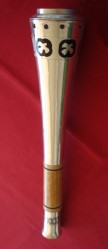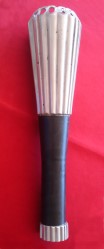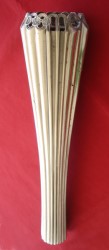Torch and Torch Relay
| The Olympic Flame
1968
In Olympia, Greece, on the clear, sunny morning of August 23, 1969, Greek actress Maria Mosxoliou placed a small amount of resin in a vessel containing a concave metal mirror. Reflected rays of intense sunlight had heated the vessel to incandescense, and at 10:30 a.m. the resin ignited and the Olympic Flame flared into existence. Every detail of the Route of the Forch was carefully planned by the Organizing Committee. It was decided that the Torch should follow the course of Columbus`s first voyage to the New World, thus symbolizing the union of the classic cultures of the Mediterranean with those of America and recalling the places and events associated with this discovery. The tree principal intermediate points along the Route of the Torch were Genoa, Italy, birthplace of Christopher Columbus; Palos, Spain, the port from which he embarked on his first voyage of discovery; and the island of San Salvador, the first land he touched in the New World. The Organizing Committee received the colla boration of the national Olympic committees of Greece, Italy and Spain, and through them the cooperation of their respective governments. Contrary to precedent, athletes from each country through which the Flame passed relayed the Olympic Torch within their national territory. (In the past, the host nation provided runners for the entire route.) The runners from the various countries wore identical uniforms designed by the Organizing Committee of the Games. They were completely white, with the exception of the shirt, which was of colors taken from the national flags of the respective countries, and bore a design of the dove of peace and the MEXICO 68 logotype. After the first lap of the journey-that from Olympia to Pyrgos-runners swept through the towns of Amalias, Patras, Aigion, Xylokastron, Kiaton, Corinth, Megara and Eleusis to Athens, where a special ceremony was held in the Panatheneum Stadium on August 24. The following day the Flame continued on to the port of Piraeus and departed for Italy aboard the Greek destroyer H.H. Navarino. |

Type A 
|

Type B 
|

Type C 
|

Type D 
|

Type E 
|
| Description: | Circle of doves around top. Inscription "Mexico 68" at the bottom. |
|---|---|
| Material | Silver color aluminum, part of shaft made of wood. ( A + B) |
| Fuel: | Mixture of nitrates, sulphur, alcalic metal carbonates, resins and silicons in fuel capsules. |
| Torch measure: | Lenght: 52 cm Weight: 780 gr |
| Torches total: | 3,000 |
| Design by: | M. Villazon |
| Manufacturer: | Producios Victor S.A. |
| Date of the torch relay: | 23. August - 12. October 1968 |
| Duration: | 25 days |
| Numbers of runners: | 2,778 |
| Distance total: | 13.620 km |
| Name of the last runner: | Enriqueta Basileo |
On August 27 the Flame arrived in Genoa, where the Greek Olympic Committee delivered it to their Italian counterparts. A ceremony was held in honor of Christopher Columbus before the house in which the great navigator was born, after which twenty-two runners relayed the Flame to the central bridge of Porta della Soprano. The next day the Flame was taken to the Ponte dei Mille naval base and carried aboard the Palinuro, a training vessel of the Italian Navy. On August 30 the Flame arrived in Barcelona, the port where Columbus was received on returning from his discovery of America. The captain of the Palinuro delivered the Flame to the vice-president of the Spanish Olympic Committee, who carried it ashore and transferred it to the torch of the first Spanish runner. He sped to the Plaza Cataluña, where the Flame was temporarily deposited in an urn. The solid fuel for the nearly three thousand Olympic Torches carried by the runners was a compressed mixture of nitrates, sulphur, alkaline metal carbonates, resins and silicons. This material-which had to remain lighted for considerable periods of time and occasionally under extreme weather conditions-produced a brillant, red-yellow flame and was non-toxic and harmless to handle. Unfortunately, it proved unexpectedly volatile. In Barcelona and again in Medinaceli minor explosions occurred during exchanges, resulting in slight burns to the runners. The cause was attributed to the too-rapid contact of a lighted torch with an unlighted one, and precautions were subsequently taken which prevented the recurrence of these incidents. From Barcelona the Flame crossed the provinces of Cataluña, Huesca and Aragon, and was briefly installed in the Temple of the Virgin of Pilar in Zaragoza. After passing through the province of Soria, the Flame arrived in Medinaceli. When it reached Madrid, the Torch was taken to Columbus Plaza, where a ceremony was held. Then, passing through Seville and Trujillo, runners relayed the Flame to the port of Palos, arriving on September 11. It was carried on the last leg of its journey through Spain by Cristóbal Colón Carbajal, a direct descendant of Columbus. At Palos the Flame was taken aboard the corvette Princesa, provided by the Spanish government for the Atlantic crossing to San Salvador, one of the Bahamas Islands. The Princesa sailed from Palos on September 12. Between Barcelona and Palos, the Olympic Flame had been carried across 1,286 kilometres of Spanish territory by an equal number of runners in eighty-eight hours and twenty minutes. The Flame was received in Las Palmas, capital of the Canary Islands, on September 14, and at San Sebastián on nearby Gomera. Fifteen days later, the Princesa arrived off San Salvador, at the exact site of Columbus's first landing in the New World. The Organizing Committee and the Bahamas Olympic Association collaborated on a special program commemorating this symbolic linking of two events: the first landing in America and the first appearance of the Olympic Flame in the New World. In the center of a plaza made up of five circular levels designed to represent the Olympic Rings, a monument was erected to receive the Flame. Six poles bore the Olympic Flag and those of Greece, Italy, Spain, the United Kingdom and Mexico-the five countries symbolically joined by the Route of the Olympic Flame. On a spiral platform in the center of the plaza was a replica of the Tlatelolco brazier, a vessel dedicated to Quetzalcóatl, a god of ancient Mexico. For five hours the Olympic Flame blazed; then, in the evening, it left San Salvador for Veracruz aboard the Mexican destroyer Durango. On the afternoon of October 6, the Durango arrived in Veracruz. The Flame was brought ashore by seventeen swimmers, who carried it in relays for approximately 850 metres, the last swimmer placing his Torch in the hands of a member of the Organizing Committee. He in turn passed it on to the first Mexican runner, who began the short journey to the Municipal Stadium. After a program of folk dances and music, the Flame was borne through the streets to the principal plaza, where Greek actress Maria Mosxoliu transferred it to a large urn. The following day, runners relayed the Flame to Jalapa, a journey of seven hours and forty minutes. Here a Mexican athlete took the oath of the relay runners and, after a brief celebration, the Flame was carried to the Municipal Palace, where it remained for the night. From Jalapa to Orizaba the Torch-bearers made their longest single-day's journey -227 kilometres. En route, the Flame stopped briefly in Córdoba. Upon arriving in Orizaba, it was taken to the football field of the Orizaba Sports Association, where the Fire from Olympia was deposited in a ritual urn for the night. As at the other stopping places along its Route, the Flame was watched over by an honor guard of local residents. The next day, Torch-bearers continued along the Route of the Torch to Cuauhtémoc Stadium in the city of Puebla. Four times between Jalapa and Puebla, near-hurricane winds extinguished the Torch, but each time it was relighted from the safety lamps ignited at Olympia. In Puebla the Flame was placed in another replica of the Tlatelolco brazier, and a splendid ballet was performed by a group of school children. The Flame was then taken to the Plaza de Armas, where it remained overnight. On the morning of October 10, the Torch-bearers set out toward Tlaxcala, passing through the villages of San Martín Texmelucan, Apizaco and Huamantla. In Huamantla, a magnificent carpet of flowers and white sand-more than three kilometres in length-was created by 2,500 local artisans for the reception of the Flame. After a brief ceremony, it continued on to Tlaxcala, where it was deposited in a vessel in Tlahuicole Stadium. Then, en route to Teotihuacan, the Flame was carried through Llano Grande, Los Reyes, Texcoco, Chiconcoac, Tizayuca, Tequisitlán, Tepexpan, Acolman and Acatlongo. In Teotihuacan, thirtyeight kilometres from Mexico City, at 7:00 p.m. on October 11 the Flame was installed on the first esplanade of the Pyramid of the Moon, and the spectacular ceremony of the New Fire unfolded (see Volume IV). |
| Country | Date | Distance | Runners | Torches |
|---|---|---|---|---|
| Greece | 23.08. - 24.08.1968 | 350 km | 350 | |
| By Greek destroyer: H.H. Navarino to Italy |
25.08 - 27.08.1968 | |||
| Italian ship "Palinuro" to Spain | 28.08. - 30.08.1968 | |||
| Spain | 30.08. - 12.09.1968 | 1,286 km | ||
| Spanish corvette "Princesa" to Bahamas | 12.09. - 29.09.1968 | |||
| Gunboat "Durango" to Mexico | - 06.10.1968 | |||
| Mexico | 06.10. - 12.10.1968 | 816 km | ||
| Total | 2,778 | 3,000 |
|
The following day the Flame began the final leg of its journey-from Teotihuacan to Mexico City. At 10:00 a.m. it reached the Monument to the Mexican People, where a great crowd of spectators gave it an enthusiastic welcome. Here, in a brief ceremony, two other Torches were lit from the Flame: one to be carried by airplane to Acapulco, site of the Olympic yachting competitions, and another to the National Museum of Anthropology, principal site of the Cultural Olympiad. The arrival of the Flame at the main entrance to the Olympic Stadium on the morning of October 12 was precisely controlled by officials in radio-equipped cars. Outside the stadium it was received by a military cadet, who passed it to Enriqueta Basilio, the first woman in the history of the Games to carry the Olympic Flame to its final destination. Holding the Torch high, she sped through the entrance and circled the track of the packed stadium, as over a hundred thousand spectators and athletes cheered and strained for a clear view. After a running ascent of the long, majestic stairway leading to the rim of the stadium, the lithe young athlete paused on the platform supporting the Olympic Cauldron, and lifted the Torch to the four cardinal points. Then she moved the Torch toward the Cauldron's jets, and the Olympic Flame surged forth to burn for the duration of the Games of the XIX Olympiad. During the fifty-day
journey, a total of 2,778 athletes participated in the relay of the Olympic
Torch, and many more served as escorts. The safety lamps lighted from the
original Fire during the ceremonies at Olympia had to be employed on thirty
different occasions. On October 15, at 10:30 p.m., the last of these security
lamps was put out. The Olympic Flame was in turn extinguished for four
years at 7:21 p.m. on Sunday evening, October 27, 1968, as the Games of
the XIX Olympiad came to a festive, triumphal close. (Source document: Official Report 1968, Vol. 2, page 243 - 248) |